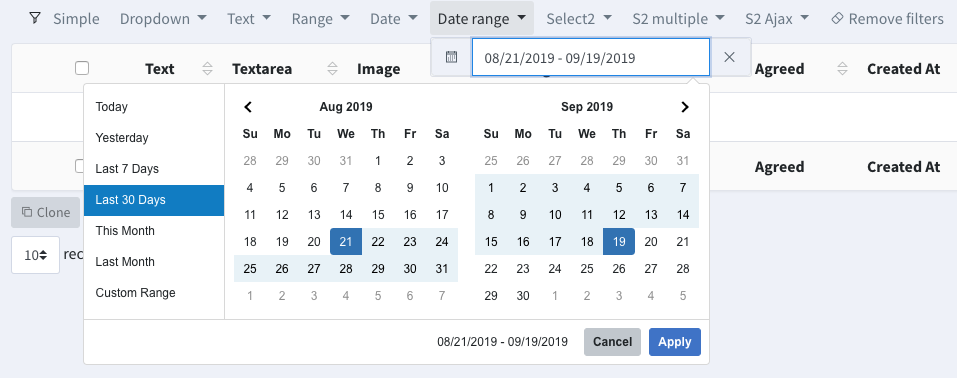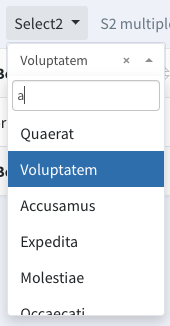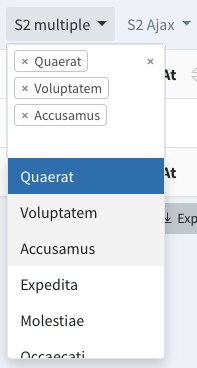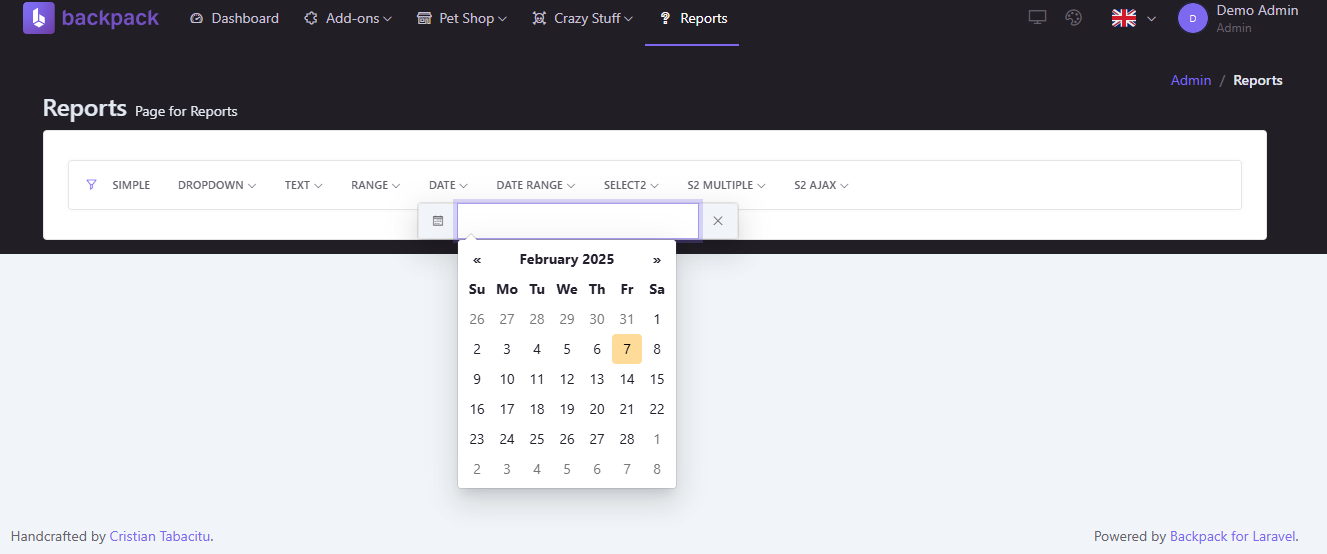Filters PRO
About
Backpack allows you to show a filters bar right above the entries table. When selected or modified, they reload the DataTable. The search bar will also take filters into account, only looking within filtered results.

Just like with fields, columns or buttons, you can add existing filters or create a custom filter that fits to your particular needs. Everything's done inside your EntityCrudController::setupListOperation().
Note: This is a PRO feature. It requires that you have purchased access to
backpack/pro.
Filters API
In order to manipulate filters, you can use:
// on one filter
CRUD::filter($name)
->type($type)
->whenActive($closure)
->whenInactive($closure)
->apply();
CRUD::filter($name)->remove();
CRUD::filter($name)->makeFirst();
CRUD::filter($name)->makeLast();
CRUD::filter($name)->before($different_filter_name);
CRUD::filter($name)->after($different_filter_name);
// on all filters
CRUD::removeAllFilters(); // removes all the filters
CRUD::filters(); // gets all the filtersAdding and configuring a filter
Inside your setupListOperation() you can add or select a filter using CRUD::filter('name'), then chain methods to completely configure it:
CRUD::filter('name')
->type('text')
->label('The name')
->whenActive(function($value) {
CRUD::addClause('where', 'name', 'LIKE', '%'.$value.'%');
})->else(function() {
// nada
});Anything you chain to the filter() method gets turned into an attribute on that filter. Except for the methods listed below. Keep in mind in most cases you WILL need to chain type(), whenActive() and maybe even whenInactive() or apply(). Details below.
Main Chained Methods
->type('date')- By chaining type() on a filter you make sure you use that filter type; it accepts a string that represents the type of filter you want to use;
CRUD::filter('birthday')->type('date');->label('Name')- By chaining label() on a filter you define what is shown to the user as the filter label; it accepts a string;
CRUD::filter('name')->label('Name');->whenActive(function($value) {})- By chaining whenActive() on a filter you define what should be done when that filter is active; it accepts a closure that is called when the filter is active - either immediately by further chainingapply()on the filter, or automatically after all filters are defined, by the List operation itself; you can also use->logic()or->ifActive()which are its aliases:
// whenActive method, applied immediately
CRUD::filter('active')
->type('simple')
->whenActive(function ($value) {
CRUD::addClause('where', 'active', '1');
})->apply();
// whenActive, left to be applied by the operation itself
CRUD::filter('active')
->type('simple')
->whenActive(function ($value) {
CRUD::addClause('where', 'active', '1');
});->whenInactive(function($value) {})- By chaining whenInactive() on a filter you define what should be done when that filter is NOT active; it accepts a closure that is called when the filter is NOT active - either immediately by further chainingapply()on the filter, or automatically after all filters are defined, by the List operation itself; you can also use->else(),->fallbackLogic(),->whenNotActive(),->ifInactive()and->ifNotActive()which are its aliases:
// fallbackLogic method, applied immediately
CRUD::filter('active')
->type('simple')
->whenActive(function ($value) {
CRUD::addClause('where', 'active', '1');
})->whenInactive(function ($value) {
CRUD::addClause('where', 'active', '0');
})->apply();
// else alias, left to be applied by the operation itself
CRUD::filter('active')
->type('simple')
->label('Simple')
->whenActive(function ($value) {
CRUD::addClause('where', 'active', '1');
})->else(function ($value) {
CRUD::addClause('where', 'active', '0');
});->apply()- By chaining apply() on a filter after you've specified the filtering logic usingwhenActive()orwhenInactive(), you immediately call the appropriate closure; in most cases this isn't necessary, because the List operation automatically performs anapply()on all filters; but in some cases, where the filtering closures want to stop or change execution, you can useapply()to have that logic applied before the next bits of code get executed;
Other Chained Methods
If you chain the following methods to a CRUD::filter('name'), they will do something very specific instead of adding that attribute to the filter:
->remove()- By chaining remove() on a filter you remove it from the current operation;
CRUD::filter('name')->remove();->forget('attribute_name')- By chaining forget('attribute_name') to a filter you remove that attribute from the filter;
CRUD::filter('price')->prefix('$'); // will have "$" as prefix
CRUD::filter('price')->forget('prefix'); // will no longer have "$" as prefix
// Note:
// You can only call "forget" on filter attributes. Calling "forget" on "before",
// "after", "whenActive", "whenInactive" etc. will do nothing, because those
// are not attributes, they are methods. You can, however, forget filter logic
// or fallback logic by using their attributes:
CRUD::filter('price')->forget('logic');
CRUD::filter('price')->forget('fallbackLogic');->after('destination')- By chaining after('destination_filter_name') you will move the current filter after the given filter;
CRUD::filter('name')->after('description');->before('destination')- By chaining before('destination_filter_name') you will move the current filter before the given filter;
CRUD::filter('name')->before('description');->makeFirst()- By chaining makeFirst() you will make the current filter the first one for the current operation;
CRUD::filter('name')->makeFirst();->makeLast()- By chaining makeLast() you will make the current filter the last one for the current operation;
CRUD::filter('name')->makeLast();Filter logic closures
Backpack filters do not contain any default filtering logic, because it cannot infer that. If you use a filter and don't specify a filter logic, no filtering of entries will actually happen. You have to define that, inside a closure.
Filter logic closures are just an anonymous functions that gets executed when the filter is active. You can use any Laravel or Backpack functionality you want inside them. For example, a valid closure would be:
CRUD::filter('draft') ->whenActive(function($value) {
CRUD::addClause('where', 'draft', 1);
});Notes about the filter logic closure:
- the code will only be run on the controller's
index()orsearch()methods; - you can get the filter value by specifying a parameter to the function (ex:
$value); - you have access to other request variables using
$this->crud->getRequest(); - you also have read/write access to public properties using
$this->crud; - when building complicated "OR" logic, make sure the first "where" in your closure is a "where" and only the subsequent are "orWhere"; Laravel 5.3+ no longer converts the first "orWhere" into a "where";
Filter Types
Simple
Only shows a label and can be toggled on/off. Useful for things like active/inactive and easily paired with Eloquent Scopes. The "Draft" and "Has Video" filters in the screenshot below are simple filters.

CRUD::filter('active')
->type('simple')
->whenActive(function() {
// CRUD::addClause('active'); // apply the "active" eloquent scope
});Text
Shows a text input. Most useful for letting the user filter through information that's not shown as a column in the CRUD table - otherwise they could just use the DataTables search field.

CRUD::filter('description')
->type('text')
->whenActive(function($value) {
// CRUD::addClause('where', 'description', 'LIKE', "%$value%");
});Date
Show a datepicker. The user can select one day.

CRUD::filter('birthday')
->type('date')
->whenActive(function($value) {
// CRUD::addClause('where', 'date', $value);
});Date range
Show a daterange picker. The user can select a start date and an end date.

CRUD::filter('from_to')
->type('date_range')
// set options to customize, www.daterangepicker.com/#options
->date_range_options([
'timePicker' => true // example: enable/disable time picker
])
->whenActive(function($value) {
// $dates = json_decode($value);
// CRUD::addClause('where', 'date', '>=', $dates->from);
// CRUD::addClause('where', 'date', '<=', $dates->to);
});Dropdown
Shows a list of elements (that you provide) in a dropdown. The user can only select one of these elements.

CRUD::filter('status')
->type('dropdown')
->values([
1 => 'In stock',
2 => 'In provider stock',
3 => 'Available upon ordering',
4 => 'Not available',
])
->whenActive(function($value) {
// CRUD::addClause('where', 'status', $value);
});Select2
Shows a select2 and allows the user to select one item from the list or search for an item. Useful when the values list is long (over 10 elements).

CRUD::filter('status')
->type('select2')
->values(function () {
return [
1 => 'In stock',
2 => 'In provider stock',
3 => 'Available upon ordering',
4 => 'Not available',
];
})
->whenActive(function($value) {
// CRUD::addClause('where', 'status', $value);
});Note: If you want to pass all entries of a Laravel model to your filter, you can do it in the closure with something like return \App\Models\Category::all()->keyBy('id')->pluck('name', 'id')->toArray();
Select2_multiple
Shows a select2 and allows the user to select one or more items from the list or search for an item. Useful when the values list is long (over 10 elements) and your user should be able to select multiple elements.

CRUD::filter('status')
->type('select2_multiple')
->values(function () {
return [
1 => 'In stock',
2 => 'In provider stock',
3 => 'Available upon ordering',
4 => 'Not available',
];
})
->whenActive(function($values) {
// CRUD::addClause('whereIn', 'status', json_decode($values));
});Note: If you want to pass all entries of a Laravel model to your filter, you can do it in the closure with something like return \App\Models\Category::all()->keyBy('id')->pluck('name', 'id')->toArray();
Select2_ajax
Shows a select2 and allows the user to select one item from the list or search for an item. This list is fetched through an AJAX call by the select2. Useful when the values list is long (over 1000 elements).

Option (A) Use the FetchOperation to return the results
Since Backpack already provides an operation that returns results from the DB, to be shown in Select2 fields, we can use that to populate the select2_ajax filter:
Step 1. In your CrudController, set up the FetchOperation to return the entity you want:
use \Backpack\CRUD\app\Http\Controllers\Operations\FetchOperation;
protected function fetchCategory()
{
return $this->fetch(\App\Models\Category::class);
}Step 2. Use this filter and make sure you specify the method as "POST":
CRUD::filter('category_id')
->type('select2_ajax')
->values(backpack_url('product/fetch/category'))
->method('POST')
->whenActive(function($value) {
// CRUD::addClause('where', 'category_id', $value);
});
// other methods
// ->placeholder('Pick a category')
// ->select_attribute('name') // the attribute that will be shown to the user by default 'name'
// ->select_key('id') // by default is ID, change it if your model uses some other keyOption (B) Use a custom controller to return the results
Alternatively, you can use a completely custom endpoint, that returns the options for the select2:
Step 1. Add a route for the ajax search, right above your usual CRUD::resource() route. Example:
Route::get('test/ajax-category-options', 'TestCrudController@categoryOptions');
CRUD::resource('test', 'TestCrudController');Step 2. Add a method to your EntityCrudController that responds to a search term. The result should be an array with id => value. Example for a 1-n relationship:
public function categoryOptions(Request $request) {
$term = $request->input('term');
$options = App\Models\Category::where('name', 'like', '%'.$term.'%')->get()->pluck('name', 'id');
// optionally you can return a paginated instance: App\Models\Category::where('name', 'like', '%'.$term.'%')::paginate(10)
return $options;
}Step 3. Add the select2_ajax filter and for the second parameter ("values") specify the exact route.
CRUD::filter('category_id')
->type('select2_ajax')
->values(url('admin/test/ajax-category-options'))
->whenActive(function($value) {
// CRUD::addClause('where', 'category_id', $value);
});
// other methods:
// ->placeholder('Pick a category')
// ->method('POST') // by default it's GET
// when returning a paginated instance you can specify the attribute and the key to be used:
// ->select_attribute('title') // by default it's name
// ->select_key('custom_key') // by default it's idRange
Shows two number inputs, for min and max.

CRUD::filter('number')
->type('range')
->whenActive(function($value) {
$range = json_decode($value);
// if ($range->from) {
// CRUD::addClause('where', 'number', '>=', (float) $range->from);
// }
// if ($range->to) {
// CRUD::addClause('where', 'number', '<=', (float) $range->to);
// }
});
// other methods
// label_from('min value')
// label_to('max value)View
Display any custom column filter you want. Usually used by Backpack package developers, to use views from within their packages, instead of having to publish them.
CRUD::filter('category_id')
->type('view')
->view('package::columns.column_type_name') // or path to blade file
->whenActive(function($value) {
// CRUD::addClause('where', 'category_id', $value);
});Creating custom filters
Creating a new filter type is as easy as using the template below and placing a new view in your resources/views/vendor/backpack/crud/filters folder. You can then call this new filter by its view's name (ex: custom_select.blade.php will mean your filter type is called custom_select).
The filters bar is actually a bootstrap navbar at its core, but slimmer. So adding a new filter will be just like adding a menu item (for the HTML). Start from the text filter below and build your functionality.
Inside this file, you'll have:
$filterobject - includes everything you've defined on the current field;$crud- the CrudPanel object;
{{-- Text Backpack CRUD filter --}}
<li filter-name="{{ $filter->name }}"
filter-type="{{ $filter->type }}"
class="dropdown {{ Request::get($filter->name) ? 'active' : '' }}">
<a href="#" class="dropdown-toggle" data-toggle="dropdown" role="button" aria-haspopup="true" aria-expanded="false">{{ $filter->label }} <span class="caret"></span></a>
<div class="dropdown-menu">
<div class="form-group backpack-filter m-b-0">
<div class="input-group">
<input class="form-control pull-right"
id="text-filter-{{ str_slug($filter->name) }}"
type="text"
@if ($filter->currentValue)
value="{{ $filter->currentValue }}"
@endif
>
<div class="input-group-addon">
<a class="text-filter-{{ str_slug($filter->name) }}-clear-button" href="#"><i class="fa fa-times"></i></a>
</div>
</div>
</div>
</div>
</li>
{{-- ########################################### --}}
{{-- Extra CSS and JS for this particular filter --}}
{{-- FILTERS EXTRA JS --}}
{{-- push things in the after_scripts section --}}
@push('crud_list_scripts')
<!-- include select2 js-->
<script>
jQuery(document).ready(function($) {
$('#text-filter-{{ str_slug($filter->name) }}').on('change', function(e) {
var parameter = '{{ $filter->name }}';
var value = $(this).val();
// behaviour for ajax table
var ajax_table = $('#crudTable').DataTable();
var current_url = ajax_table.ajax.url();
var new_url = addOrUpdateUriParameter(current_url, parameter, value);
// replace the datatables ajax url with new_url and reload it
new_url = normalizeAmpersand(new_url.toString());
ajax_table.ajax.url(new_url).load();
// mark this filter as active in the navbar-filters
if (URI(new_url).hasQuery('{{ $filter->name }}', true)) {
$('li[filter-name={{ $filter->name }}]').removeClass('active').addClass('active');
} else {
$('li[filter-name={{ $filter->name }}]').trigger('filter:clear');
}
});
$('li[filter-name={{ str_slug($filter->name) }}]').on('filter:clear', function(e) {
$('li[filter-name={{ $filter->name }}]').removeClass('active');
$('#text-filter-{{ str_slug($filter->name) }}').val('');
});
// datepicker clear button
$(".text-filter-{{ str_slug($filter->name) }}-clear-button").click(function(e) {
e.preventDefault();
$('li[filter-name={{ str_slug($filter->name) }}]').trigger('filter:clear');
$('#text-filter-{{ str_slug($filter->name) }}').val('');
$('#text-filter-{{ str_slug($filter->name) }}').trigger('change');
})
});
</script>
@endpush
{{-- End of Extra CSS and JS --}}
{{-- ########################################## --}}Examples
Use a dropdown to filter by the values of a MySQL ENUM column:
CRUD::filter('published')
->type('select2')
->values(function() {
return \App\Models\Test::getEnumValuesAsAssociativeArray('published');
})
->whenActive(function($value) {
CRUD::addClause('where', 'published', $value);
});Use a select2 to filter by a 1-n relationship:
CRUD::filter('category_id')
->type('select2')
->values(function() {
return \App\Models\Category::all()->pluck('name', 'id')->toArray();
})
->whenActive(function($value) {
CRUD::addClause('where', 'category_id', $value);
});Use a select2_multiple to filter Products by an n-n relationship:
CRUD::filter('tags')
->type('select2_multiple')
->values(function() { // the options that show up in the select2
return Product::all()->pluck('name', 'id')->toArray();
})
->whenActive(function($values) {
foreach (json_decode($values) as $key => $value) {
$this->crud->query = $this->crud->query->whereHas('tags', function ($query) use ($value) {
$query->where('tag_id', $value);
});
}
});Use a simple filter to add a scope if the filter is active:
// add a "simple" filter called Published
CRUD::filter('published')
->type('simple')
->whenActive(function() { // if the filter is active (the GET parameter "published" exits)
CRUD::addClause('published');
});Use a simple filter to show the softDeleted items (trashed):
CRUD::filter('trashed')
->type('simple')
->whenActive(function($values) {
$this->crud->query = $this->crud->query->onlyTrashed();
});Tips and Tricks
Use Filters on custom admin panel pages
Filters can be added to any admin panel page, not just the main CRUD table. Imagine that you want to have a dashboard page, with a few widgets that show some data. You can add filters to that page, and use them to filter the data shown in the widgets.

You start by creating a new page to hold your custom content, eg: a reports page.
php artisan backpack:page ReportsTo use filters on a custom admin panel page, you should edit the blade file (in this example the resources/views/admin/reports.blade.php file) to add the filters navbar and the event listeners:
@extends(backpack_view('blank'))
@section('content')
<section class="header-operation container-fluid animated fadeIn d-flex mb-2 align-items-baseline d-print-none" bp-section="page-header">
<h1 class="text-capitalize mb-0" bp-section="page-heading">Reports</h1>
<p class="ms-2 ml-2 mb-0" bp-section="page-subheading">Page for Reports</p>
</section>
<section class="content container-fluid animated fadeIn" bp-section="content">
<div class="row">
<div class="col-md-12">
<div class="card">
<div class="card-body">
+ @include('crud::inc.filters_navbar')
</div>
</div>
</div>
</div>
@endsection
+@push('after_scripts')
+<script>
+ document.addEventListener('backpack:filters:cleared', function (event) {
+ console.log('all filters cleared', event);
+ });
+
+ document.addEventListener('backpack:filter:cleared', function (event) {
+ console.log('one filter cleared', event);
+ });
+
+ document.addEventListener('backpack:filter:changed', function (event) {
+ let filterName = event.detail.filterName;
+ let filterValue = event.detail.filterValue;
+ let shouldUpdateUrl = event.detail.shouldUpdateUrl;
+ console.log('one filter changed', filterName, filterValue, shouldUpdateUrl);
+ });
+</script>
+@endpushAfter that, time to add your own filters in your controller (in this example, ReportsController.php):
class ReportsController extends Controller
{
public function index()
{
$crud = app('crud');
$crud->addFilter([
'type' => 'simple',
'name' => 'checkbox',
'label' => 'Simple',
], false);
$crud->addFilter([ // dropdown filter
'name' => 'select_from_array',
'type' => 'dropdown',
'label'=> 'Dropdown',
], ['one' => 'One', 'two' => 'Two', 'three' => 'Three']);
return view('admin.reports', [
'title' => 'Reports',
'breadcrumbs' => [
trans('backpack::crud.admin') => backpack_url('dashboard'),
'Reports' => false,
],
'crud' => $crud,
]);
}
}That's it, you should now have the filters navbar on your reports page. You can use the event listeners to update the data shown on the page based on the filters selected by the user. Here are the Javascript events you can listen to:
backpack:filter:changedwhen a filter is changed;backpack:filter:clearedwhen a filter is cleared;backpack:filters:clearedwhen all filters are cleared;
Add a debounce time to filters
Filters can be debounced, so that the filtering logic is only applied after the user has stopped typing for a certain amount of time. This is useful when the filtering logic is expensive and you don't want it to run on every keystroke. To debounce a filter, you can use the following code:
CRUD::filter('name')
->type('text')
->debounce(1000) // debounce time in milliseconds
->whenActive(function($value) {
// CRUD::addClause('where', 'name', 'LIKE', "%$value%");
});All filter types accept a debounce, like for example the simple filter, range filter etc.
Add a filter using array syntax
In Backpack v4-v5 we used an "array syntax" to add and manipulate filters. That syntax is still supported for backwards-compatiblity. But it most cases it's easier to use the fluent syntax.
When adding a filter using the array syntax you need to specify the 3 parameters of the addFilter() method:
$options- an array of options (name, type, label are most important)$values- filter values - can be an array or a closure$filter_logic- what should happen if the filter is applied (usually add a clause to the query) - can be a closure, a string for a simple operation or false for a simple "where";
Here's a simple example, with comments that explain what we're doing:
// add a "simple" filter called Draft
$this->crud->addFilter([
'type' => 'simple',
'name' => 'draft',
'label' => 'Draft'
],
false, // the simple filter has no values, just the "Draft" label specified above
function() { // if the filter is active (the GET parameter "draft" exits)
CRUD::addClause('where', 'draft', '1');
// we've added a clause to the CRUD so that only elements with draft=1 are shown in the table
// an alternative syntax to this would have been
// $this->crud->query = $this->crud->query->where('draft', '1');
// another alternative syntax, in case you had a scopeDraft() on your model:
// CRUD::addClause('draft');
});